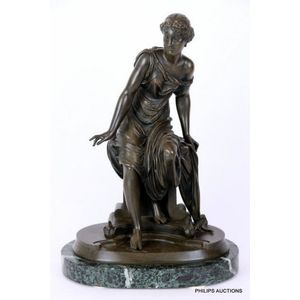Seated Maiden Bronze Figure by Emile Bruchon
A French bronze figure, Emile Bruchon, 19th century, the French bronze figure of a seated maiden, cast in a classical Belle Epoque style, with Bruchon signature inscribed to the side, depicts a maiden draped in a finely cast flowing toga to step down from a Roman column pedestal, mounted on an oval veined marble base; patina on bronze consistent with age, height 41 cm, width 29 cm depth 18 cm
You must be a subscriber, and be logged in to view price and dealer details.
Subscribe Now to view actual auction price for this item
When you subscribe, you have the option of setting the currency in which to display prices to $Au, $US, $NZ or Stg.
This item has been sold, and the description, image and price are for reference purposes only.
- Belle Epoque - The Belle Époque, also known as the "Beautiful Era," was a period in European history that lasted from the late 19th century to the outbreak of World War I in 1914. The term is most commonly associated with France, but is also used to refer to the same period in other countries, particularly in Western Europe and Latin America.
During the Belle Époque, Europe experienced a time of great prosperity and cultural, artistic, and scientific advancements. It was an era of peace and optimism, characterized by industrial growth, urbanization, and new technologies such as electricity, automobiles, and the telephone. The period is also associated with a flourishing of art and culture, particularly in the fields of literature, music, and the visual arts. - Patination / Patina - In broad terms, patination refers to the exterior surface appearance of the timber, the effect of fading caused by exposure to sunlight and air over the course of a century or more, changing the piece to a soft, mellow colour.
As patina is very difficult to replicate, it is one of the most important guides to determining the age of furniture.
Patina is also the term applied to the bloom or film found on old bronzes due to oxidisation. - Bronze - An alloy of copper and tin, traditionally in the proportions of about 9 parts of copper to 1 part of tin.
The discovery of bronze in Western Asia in the 4th century enabled people to create metal objects which were superior to those previoulsy possible because of its strength and hardness, and it has been used throughout the world for weapons, coins, tools, statuary and other decorative items.
It is very fluid in a molten state, and its hardness, strength when set, and non-corrosive properties makes it most suitable for casting sculpture.
This item has been included into following indexes:
